HON HAI PRECISION IND T77H462 802.11abgn+BT4.0 module User Manual Acer PSI date EN
HON HAI Precision Ind. Co., Ltd. 802.11abgn+BT4.0 module Acer PSI date EN
Contents
Regulatory Information and Safety Guide

- 1
Regulatory Information and
Safety Guide
2 -
© 2013. All Rights Reserved.
Regulatory Information and Safety Guide
This revision: December 2013

Table of contents - 3
TABLE OF CONTENTS
Tips and information for comfortable
use 4
Finding your comfort zone .......................... 4
Taking care of your vision........................... 5
Developing good work habits...................... 6
Protecting your hearing............................... 6
Basic care and tips for using your
computer 7
Turning your computer on and off............... 7
Taking care of your computer ..................... 7
General ....................................................... 8
Safety instructions ................................... 9
Product servicing ........................................ 9
Cleaning and servicing................................ 9
Battery and adapter information ............ 10
Accessing the power................................. 10
Disconnecting the power source............... 10
Using electrical power............................... 10
Guidelines for safe battery usage ............. 12
Warnings and regulatory information 14
Optical drives......................................... 14
Telephone line safety............................. 14
Emergency calls........................................ 15
Medical devices ..................................... 15
Vehicles ................................................. 16
Potentially explosive environments........ 16
Disposal instructions.............................. 17
ENERGY STAR..................................... 17
Wireless equipment regulatory
information................................................18
Radio frequency interference.................... 18
Use on aircraft........................................... 19
The wireless equipment and your health....19
USA — FCC and FAA............................... 19
FCC radio frequency interference
requirements............................................. 20
Canada — Industry Canada (IC) .............. 22
European Union........................................ 22
Compliant with Russian regulatory
certification................................................ 28

4 - Tips and information for comfortable use
TIPS AND INFORMATION FOR
COMFORTABLE USE
Computer users may complain of eyestrain and headaches after
prolonged use. Users are also at risk of physical injury after long
hours of working in front of a computer. Long work periods, bad
posture, poor work habits, stress, inadequate working conditions,
personal health and other factors greatly increase the risk of physical
injury.
Incorrect computer usage may lead to carpal tunnel syndrome,
tendonitis, tenosynovitis or other musculoskeletal disorders. The
following symptoms may appear in the hands, wrists, arms, shoulders,
neck or back:
• Numbness, or a burning or tingling sensation.
• Aching, soreness or tenderness.
• Pain, swelling or throbbing.
• Stiffness or tightness.
• Coldness or weakness.
If you have these symptoms, or any other recurring or persistent
discomfort and/or pain related to computer use, consult a physician
immediately and inform your company's health and safety
department.
The following section provides tips for more comfortable computer
use.
Finding your comfort zone
Find your comfort zone by adjusting the viewing angle of the monitor,
using a footrest, or raising your sitting height to achieve maximum
comfort. Observe the following tips:
• Refrain from staying too long in one fixed posture.
Important
Some of the information in this guide may not apply to your computer.
Tips and information for comfortable use - 5
• Avoid slouching forward and/or leaning backward.
• Stand up and walk around regularly to remove the strain on your leg
muscles.
• Take short rests to relax your neck and shoulders.
• Avoid tensing your muscles or shrugging your shoulders.
• Install the external display, keyboard and mouse properly and within
comfortable reach.
• If you view your monitor more than your documents, place the
display at the center of your desk to minimize neck strain.
Taking care of your vision
Long viewing hours, wearing incorrect glasses or contact lenses,
glare, excessive room lighting, poorly focused screens, very small
typefaces and low-contrast displays could stress your eyes. The
following sections provide suggestions on how to reduce eyestrain.
Eyes
• Rest your eyes frequently.
• Give your eyes regular breaks by looking away from the monitor and
focusing on a distant point.
• Blink frequently to keep your eyes from drying out.
Display
• Keep your display clean.
• Keep your head at a higher level than the top edge of the display so
your eyes point downward when looking at the middle of the display.
• Adjust the display brightness and/or contrast to a comfortable level
for enhanced text readability and graphics clarity.
• Eliminate glare and reflections by:
• placing your display in such a way that the side faces the window
or any light source,
• minimizing room light by using drapes, shades or blinds,
• using a task light,
• changing the display's viewing angle,
• using a glare-reduction filter,

6 - Tips and information for comfortable use
• using a display visor, such as a piece of cardboard extended from
the display's top front edge.
• Avoid adjusting your display to an awkward viewing angle.
• Avoid looking at bright light sources for extended periods of time.
Developing good work habits
The following work habits make computer use more relaxing and
productive:
• Take short breaks regularly and often.
• Perform some stretching exercises.
• Breathe fresh air as often as possible.
• Exercise regularly and maintain a healthy body.
Protecting your hearing
To protect your hearing, follow these instructions.
• Increase the volume gradually until you can hear clearly and
comfortably.
• Do not increase the volume level after your ears have adjusted.
• Do not listen to music at high volumes for extended periods.
• Do not increase the volume to block out noisy surroundings.
• Decrease the volume if you can't hear people speaking near you.
Warning
We do not recommend using the computer on a couch or bed. If this is
unavoidable, work for only short periods, take breaks regularly, and do
some stretching exercises.
Warning
Permanent hearing loss may occur if earphones or
headphones are used at high volume for prolonged periods of
time.

Basic care and tips for using your computer - 7
BASIC CARE AND TIPS FOR USING
YOUR COMPUTER
Read these instructions carefully. Keep this document for future
reference. Follow all warnings and instructions marked on the product.
Turning your computer on and off
To turn on the computer, simply press and release the power button.
Please refer to the setup poster for the location of the power button.
To turn the power off, do any of the following:
• Use the Windows shutdown command: Press the Windows key +
<C>, click Settings > Power then click Shut Down.
If you need to power down the computer for a short while, but don’t
want to completely shut it down, you can put it into Hibernate by:
• Pressing the power button.
You can also put the computer in sleep mode by pressing the sleep
hotkey <Fn> + <F4>.
Taking care of your computer
Your computer will serve you well if you take care of it.
• Do not expose the computer to direct sunlight. Do not place it near
sources of heat, such as a radiator.
• Do not expose the computer to temperatures below 0° C (32° F) or
above 50° C (122° F).
• Do not subject the computer to magnetic fields.
• Do not expose the computer to rain or moisture.
• Do not spill water or any liquid on the computer.
Note
If you cannot power off the computer normally, press and hold the power
button for more than four seconds to shut down the computer. If you turn off
the computer and want to turn it on again, wait at least two seconds before
powering up.
8 - Basic care and tips for using your computer
• Do not subject the computer to heavy shock or vibration.
• Do not expose the computer to dust or dirt.
• Never place objects on top of the computer.
• Do not slam the computer display when you close it.
• Never place the computer on uneven surfaces.
General
• Do not use this product near water.
• Do not place this product on an unstable cart, stand or table. If the
product falls, it could be seriously damaged.
• Slots and openings are provided for ventilation to ensure reliable
operation of the product and to protect it from overheating. These
openings must not be blocked or covered. The openings should
never be blocked by placing the product on a bed, sofa, rug or other
similar surface. This product should never be placed near or over a
radiator or heat register, or in a built-in installation unless proper
ventilation is provided.
• Never push objects of any kind into this product through cabinet
slots as they may touch dangerous voltage points or short-out parts
that could result in a fire or electric shock. Never spill liquid of any
kind onto or into the product.
• To avoid damage of internal components and to prevent battery
leakage, do not place the product on a vibrating surface.
• Never use it under sporting, exercising, or any vibrating environment
which will probably cause a short-circuit or damage rotor devices,
HDD, optical drive, and even exposure risk from the lithium battery
pack.
• The bottom surface, areas around ventilation openings and AC
adapter may get hot. To avoid injury, ensure they do not come in
contact with your skin or body.
• Your device and its enhancements may contain small parts. Keep
them out of the reach of small children.
• The surface temperature of the base will rise during normal
operation, particularly when plugged in to AC power. Allowing
sustained contact with exposed skin can cause discomfort or burns.

Basic care and tips for using your computer - 9
Safety instructions
Product servicing
Do not attempt to service this product yourself, as opening or
removing covers may expose you to dangerous voltage points or
other risks. Refer all servicing to qualified service personnel.
Unplug this product from the wall outlet and refer servicing to qualified
service personnel when:
• The power cord or plug is damaged, cut or frayed.
• Liquid was spilled into the product.
• The product was exposed to rain or water.
• The product has been dropped or the case has been damaged.
• The product exhibits a distinct change in performance, indicating a
need for service.
• The product does not operate normally after following the operating
instructions.
•The product exhibits a distinct change in performance, indicating a
need for service.
• The product does not operate normally after following the operating
instructions.
Cleaning and servicing
When cleaning the computer, follow these steps:
1.Turn off the computer and remove the battery pack.
2.Disconnect the AC adapter.
3.Use a soft, moist cloth. Do not use liquid or aerosol cleaners.
Note
Adjust only those controls that are covered by the operating instructions,
since improper adjustment of other controls may result in damage and will
often require extensive work by a qualified technician to restore the product
to normal condition.
10 - Basic care and tips for using your computer
Battery and adapter information
Accessing the power
Be sure that the power outlet you plug into is easily accessible and
located as close to the equipment operator as possible. When you
need to disconnect power to the equipment, be sure to unplug from
the electrical outlet.
Disconnecting the power source
Observe the following guidelines when connecting and disconnecting
power to the power supply unit:
Install the power supply unit before connecting to the AC power outlet.
Unplug before removing the power supply unit from the computer.
If the system has multiple sources of power, disconnect power from
the system by unplugging all power cords from the power supplies.
Using electrical power
• Do not connect the adapter to any other device.
• When unplugging the power cord, do not pull on the cord itself but
pull on the plug.
• This product should be operated from the type of power indicated on
the marking label. If you are not sure of the type of power available,
consult your dealer or local power company.
• Do not allow anything to rest on the power cord. Do not locate this
product where people will walk on the cord.
• If an extension cord is used with this product, make sure that the
total ampere rating of the equipment plugged into the extension cord
does not exceed the extension cord ampere rating. Also, make sure
that the total rating of all products plugged into the wall outlet does
not exceed the fuse rating.
• Do not overload a power outlet, strip or receptacle by plugging in too
many devices. The overall system load must not exceed 80% of the
branch circuit rating. If power strips are used, the load should not
exceed 80% of the power strip's input rating.
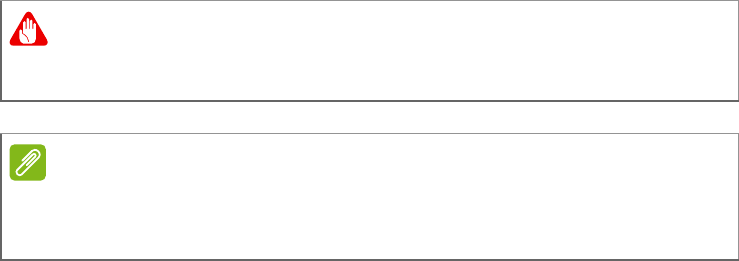
Basic care and tips for using your computer - 11
• If this product's AC adapter is equipped with a three-wire grounded
plug. The plug only fits in a grounded power outlet. Make sure the
power outlet is properly grounded before inserting the AC adapter
plug. Do not insert the plug into a non-grounded power outlet.
Contact your electrician for details.
• The system can be powered using a wide range of voltages; 100 to
120 or 220 to 240 V or 100-240 V AC. The power cord included with
the system meets the requirements for use in the country/region
where the system was purchased. Power cords for use in other
countries/regions must meet the requirements for that country/
region. For more information on power cord requirements, contact
an authorized reseller or service provider.
Warning
The grounding pin is a safety feature. Using a power outlet that is not
properly grounded may result in electric shock and/or injury.
Note
The grounding pin also provides good protection from unexpected noise
produced by other nearby electrical devices that may interfere with the
performance of this product.

12 - Basic care and tips for using your computer
Guidelines for safe battery usage
This notebook uses a Lithium battery. Do not use it in a humid, wet or
corrosive environment. Do not put, store or leave your product in or
near a heat source, in a high temperature location, in strong direct
sunlight, in a microwave oven or in a pressurized container, and do
not expose it to temperatures over 60° C (140° F).
Failure to follow these guidelines may cause the battery to leak acid,
become hot, explode or ignite and cause injury and/or damage. Do
not pierce, open or disassemble the battery. If the battery leaks and
you come into contact with the leaked fluids, rinse thoroughly with
water and seek medical attention immediately. For safety reasons,
and to prolong the lifetime of the battery, charging will not occur at
temperatures below 0° C (32° F) or above 40° C (104° F).
The full performance of a new battery is achieved only after two or
three complete charge and discharge cycles. The battery can be
charged and discharged hundreds of times, but it will eventually wear
out. When the operation time becomes noticeably shorter than
normal, buy a new battery. Use only the approved batteries, and
recharge your battery only with the approved chargers designated for
this device.
Use the battery only for its intended purpose. Never use any charger
or battery that is damaged. Do not short-circuit the battery. Accidental
short-circuiting can occur when a metallic object such as a coin, clip or
pen causes direct connection of the positive (+) and negative (-)
terminals of the battery. (These look like metal strips on the battery.)
This might happen, for example, when you carry a spare battery in
Warning
Batteries may explode if not handled properly. Do not disassemble or
dispose of them in fire.
Do not tamper with batteries. Keep them away from children.
Follow local regulations when disposing of used batteries.
Important
Replace the battery with the same type as that which came bundled with
your product. Use of another battery may present a risk of fire or
explosion.

Basic care and tips for using your computer - 13
your pocket or purse. Short-circuiting the terminals may damage the
battery or the connecting object.
The capacity and lifetime of the battery will be reduced if the battery is
left in hot or cold places, such as in a closed car in summer or winter.
Always try to keep the battery between 15° C and 25° C (59° F and
77° F). A device with a hot or cold battery may not work temporarily,
even when the battery is fully charged. Battery performance is
especially limited in temperatures well below freezing.
Do not dispose of batteries in a fire as they may explode. Batteries
may also explode if damaged. Dispose of batteries according to local
regulations. Please recycle when possible. Do not dispose as
household waste.
Wireless devices may be susceptible to interference from the battery,
which could affect performance.
Note
Please refer to www.acer.com for battery shipping documents.

14 - Warnings and regulatory information
WARNINGS AND REGULATORY
INFORMATION
Optical drives
CAUTION: This appliance contains a laser system and is classified as
a "CLASS 1 LASER PRODUCT." In case of any trouble with this
device, please contact your nearest AUTHORIZED service station. To
prevent direct exposure to the laser beam, do not try to open the
enclosure.
CLASS 1 LASER PRODUCT
CAUTION: INVISIBLE LASER RADIATION WHEN OPEN. AVOID
EXPOSURE TO BEAM.
APPAREIL A LASER DE CLASSE 1 PRODUIT
LASERATTENTION: RADIATION DU FAISCEAU LASER INVISIBLE
EN CAS D’OUVERTURE. EVITTER TOUTE EXPOSITION AUX
RAYONS.
LUOKAN 1 LASERLAITE LASER KLASSE 1
VORSICHT: UNSICHTBARE LASERSTRAHLUNG, WENN
ABDECKUNG GEÖFFNET NICHT DEM STRAHLL AUSSETZEN
PRODUCTO LÁSER DE LA CLASE I
ADVERTENCIA: RADIACIÓN LÁSER INVISIBLE AL SER ABIERTO.
EVITE EXPONERSE A LOS RAYOS.
ADVARSEL: LASERSTRÅLING VEDÅBNING SE IKKE IND I
STRÅLEN.
VARO! LAVATTAESSA OLET ALTTINA LASERSÅTEILYLLE.
VARNING: LASERSTRÅLNING NÅR DENNA DEL ÅR ÖPPNAD ÅLÅ
TUIJOTA SÅTEESEENSTIRRA EJ IN I STRÅLEN
VARNING: LASERSTRÅLNING NAR DENNA DEL ÅR
ÖPPNADSTIRRA EJ IN I STRÅLEN
ADVARSEL: LASERSTRÅLING NAR DEKSEL ÅPNESSTIRR IKKE
INN I STRÅLEN
Telephone line safety

Warnings and regulatory information - 15
• Disconnect all telephone lines from the equipment when not in use
and/or before servicing.
• To avoid the remote risk of electric shock from lightning, do not
connect the telephone line to this equipment during lightning or
thunderstorms.
Emergency calls
Medical devices
Operation of any radio transmitting equipment, including wireless
phones, may interfere with the functionality of inadequately protected
medical devices. Consult a physician or the manufacturer of the
medical device to determine if they are adequately shielded from
external RF energy or if you have any questions. Switch off your
device in health care facilities when any regulations posted in these
areas instruct you to do so. Hospitals or health care facilities may be
using equipment that could be sensitive to external RF transmissions.
Pacemakers. Pacemaker manufacturers recommend that a minimum
separation of 15.3 centimeters (6 inches) be maintained between
wireless devices and a pacemaker to avoid potential interference with
the pacemaker. These recommendations are consistent with the
independent research by and recommendations of Wireless
Technology Research. Persons with pacemakers should do the
following:
• Always keep the device more than 15.3 centimeters (6 inches) from
the pacemaker
• Not carry the device near your pacemaker when the device is
switched on. If you suspect interference, switch off your device, and
move it.
Hearing aids. Some digital wireless devices may interfere with some
hearing aids. If interference occurs, consult your service provider.
Warning
You cannot make emergency calls through this device. To make an
emergency call you shall dial out through your mobile phone or other
telephone call system.

16 - Warnings and regulatory information
Vehicles
RF signals may affect improperly installed or inadequately shielded
electronic systems in motor vehicles such as electronic fuel injection
systems, electronic antiskid (anti-lock) braking systems, electronic
speed control systems, and air bag systems. For more information,
check with the manufacturer, or its representative, of your vehicle or
any equipment that has been added. Only qualified personnel should
service the device, or install the device in a vehicle. Faulty installation
or service may be dangerous and may invalidate any warranty that
may apply to the device. Check regularly that all wireless equipment
in your vehicle is mounted and operating properly. Do not store or
carry flammable liquids, gases, or explosive materials in the same
compartment as the device, its parts, or enhancements. For vehicles
equipped with an air bag, remember that air bags inflate with great
force. Do not place objects, including installed or portable wireless
equipment in the area over the air bag or in the air bag deployment
area. If in-vehicle wireless equipment is improperly installed, and the
air bag inflates, serious injury could result. Using your device while
flying in aircraft is prohibited. Switch off your device before boarding
an aircraft. The use of wireless teledevices in an aircraft may be
dangerous to the operation of the aircraft, disrupt the wireless
telephone network, and may be illegal.
Potentially explosive environments
Switch off your device when in any area with a potentially explosive
atmosphere and obey all signs and instructions. Potentially explosive
atmospheres include areas where you would normally be advised to
turn off your vehicle engine. Sparks in such areas could cause an
explosion or fire resulting in bodily injury or even death. Switch off the
device at refueling points such as near gas pumps at service stations.
Warning
Do not operate a portable transmitter (including this wireless
equipment) near unshielded blasting caps or in an explosive
environment unless the transmitter has been modified to be qualified
for such use.
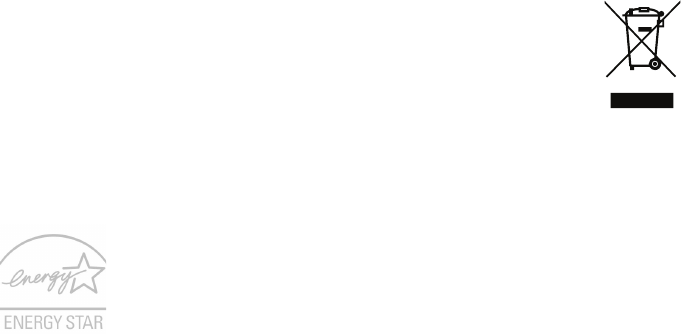
Warnings and regulatory information - 17
Observe restrictions on the use of radio equipment in fuel depots,
storage, and distribution areas; chemical plants; or where blasting
operations are in progress.
Areas with a potentially explosive atmosphere are often, but not
always, clearly marked. They include below deck on boats, chemical
transfer or storage facilities, vehicles using liquefied petroleum gas
(such as propane or butane), and areas where the air contains
chemicals or particles such as grain, dust or metal powders.
Do not switch the notebook on when wireless phone use is prohibited
or when it may cause interference or danger.
Disposal instructions
Do not throw this electronic device into the trash when
discarding. To minimize pollution and ensure utmost
protection of the global environment, please recycle. For
more information on the Waste from Electrical and
Electronics Equipment (WEEE) regulations, visit
www.acer-group.com/public/Sustainability
ENERGY STAR
Acer's ENERGY STAR qualified products save your
money by reducing energy cost and protecting the
environment without sacrificing features or performance.
Acer is proud to offer our customers products with the
ENERGY STAR mark.
What is ENERGY STAR?
Products that are ENERGY STAR qualified use less energy and
prevent greenhouse gas emissions by meeting strict energy efficiency
guidelines set by the U.S. Environmental Protection Agency. Acer is
committed to offering products and services worldwide that help
customers save money, conserve energy and improve the quality of
our environment. The more energy we can save through higher
energy efficiency, the more we reduce greenhouse gases and the
risks of climate change. More information refers to
www.energystar.gov or www.energystar.gov/powermanagement.

18 - Warnings and regulatory information
Acer ENERGY STAR qualified products:
• Produce less heat and reduce cooling loads, and warmer climates.
• Automatically go into "display sleep" and "computer sleep" mode
after 10 and 30 minutes of inactivity respectively.
• Wake the computer from sleep mode by pushing keyboard or
moving mouse.
• Computers will save more than 80% energy at "sleep" mode.
ENERGY STAR and the ENERGY STAR mark are registered U.S.
marks
Wireless equipment regulatory information
Radio frequency interference
Remember to follow any special regulations in force in any area, and
always switch off your device when its use is prohibited or when it
may cause interference or danger. Use the device only in its normal
operating positions. This device meets RF exposure guidelines when
used normally. To successfully transmit data files or messages, this
device requires a good quality connection to the network. In some
cases, transmission of data files or messages may be delayed until
such a connection is available. Parts of the device are magnetic.
Metallic materials may be attracted to the device, and persons with
hearing aids should not hold the device to the ear with the hearing aid.
Do not place credit cards or other magnetic storage media near the
device, because information stored on them may be erased.
Note
Information in this section may not apply to your computer.
Warning
For safety reasons, turn off all wireless or radio transmitting devices
when using your laptop under the following conditions. These devices
may include, but are not limited to: wireless LAN (WLAN), Bluetooth
and/or 3G.

Warnings and regulatory information - 19
Use on aircraft
The wireless equipment and your health
The wireless equipment, like other radio devices, emits radio
frequency electromagnetic energy. The level of energy emitted by
the wireless equipment, however, is less than the electromagnetic
energy emitted by other wireless devices such as mobile phones. The
wireless equipment operates within the guidelines found in radio
frequency safety standards and recommendations. These
standards and recommendations reflect the consensus of the
scientific community and result from deliberations of panels and
committees of scientists who continually review and interpret the
extensive research literature. In some situations or environments, the
use of the wireless equipment may be restricted by the proprietor
of the building or responsible representatives of the applicable
organization. Examples of such situations may include:
•Using the wireless equipment on board airplanes, or
•Using the wireless equipment in any other environment where the risk
of interference with other devices or services is perceived or
identified as being harmful.
If you are uncertain of the policy that applies to the use of
wireless equipment in a specific organization or environment (an
airport, for example), you are encouraged to ask for
authorization to use the adapter before you turn it on.
USA — FCC and FAA
The FCC with its action in ET Docket 96-8 has adopted a safety
standard for human exposure to radio frequency (RF)
electromagnetic energy emitted by FCC certified equipment. The
wireless equipment meets the Human Exposure limits found
in OET Bulletin 65,
Warning
FCC and FAA regulations may prohibit airborne operation of
radio-frequency wireless devices (wireless equipment) because their
signals could interfere with critical aircraft instruments. Ask the
cabin crew before turning on your device’s wireless equipment whilst
on board.

20 - Warnings and regulatory information
supplement C, 2001, and ANSI/IEEE C95.1, 1992. Proper operation
of this radio according to the instructions found in this manual will
result in exposure substantially below the FCC’s recommended limits.
• The following safety precautions should be observed:
Do not touch or move antenna while the unit is transmitting or
receiving.
• Do not hold any component containing the radio such that the
antenna is very close or touching any exposed parts of the body,
especially the face or eyes, while transmitting.
• Do not operate the radio or attempt to transmit data unless the
antenna is connected; this behavior may cause damage to the
radio.
•The use of wireless equipment in hazardous locations is limited by the
constraints posed by the safety directors of such environments.
•The use of wireless equipment on airplanes is governed by the
Federal Aviation Administration (FAA).
•The use of wireless equipment in hospitals is restricted to the limits
set forth by each hospital.
FCC radio frequency interference requirements
The product comply with the FCC portable RF exposure limit set
forth for an uncontrolled environment and are safe for intended
operation as described in this manual. The further RF exposure
reduction can be achieved if the product can be kept as far as
possible from the user body or set the device to lower output
power if such function is available.
Explosive Device Proximity Warning
Warning: Do not operate a portable transmitter (including this
wireless equipment) near unshielded blastingcaps or in an explosive
environment unless the transmitter has been modified to be qualified
for such use.
Note
Applies to device supporting IEEE 802.11a wireless equipments.

USA — Federal Communications Commission (FCC)
Interference statement
This wireless equipment has been tested and found to comply with
the limits for a Class B digital device, pursuant to Part 15 of the
FCC Rules. These limits are designed to provide reasonable
protection against harmful interference in a residential installation.
This wireless equipment generates, uses, and can radiate radio
frequency energy. If the wireless equipment is not installed and
used in accordance with the instructions, the wireless equipment
may cause harmful interference to radio communications. There is
no guarantee, however, that such interference will not occur in a
particular installation. If this wireless equipment does cause
harmful interference to radio or television reception (which can
be determined by turning the equipment off and on), the user is
encouraged to try to correct the interference by taking one or more of
the following measures:
This device complies with part 15 of the FCC Rules. Operation is
subject to the following two conditions:
(1) This device may not cause harmful interference, and
(2) this device must accept any interference received, including
interference that may cause undesired operation.
Radiation Exposure Statement:
The product comply with the FCC portable RF exposure limit set forth
for an uncontrolled environment and are safe for intended operation
as described in this manual. The further RF exposure reduction can
be achieved if the product can be kept as far as possible from the
user body or set the device to lower output power if such function is
available.
This device is restricted to indoor use due to its operation in the 5.15 to 5.25
GHz and 5.470 to 5.725 GHz frequency ranges. FCC requires this product
to be used indoors for the frequency ranges 5.15 to 5.25 GHz and
5.470 to 5.725 GHz to reduce the potential for harmful interference to co-
channel mobile satellite systems. High power radars are allocated as
primary users of the 5.25 to 5.35 GHz and 5.65 to 5.85 GHz bands.
These radar stations can cause interference with and /or damage this
device. No configuration controls are provided for this wireless
equipment allowing any change in the frequency of operations outside
the FCC grant of authorization for U.S operation according to Part 15.407 of
the FCC rules.
Warnings and regulatory information - 21
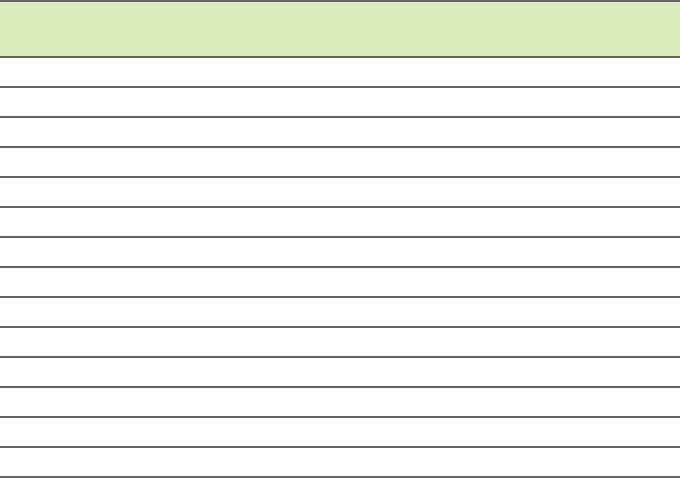
22 - Warnings and regulatory information
•Connect the computer with the wireless equipment to an outlet
on a circuit different from that to which the equipment
experiencing the interference is connected.
• Consult the dealer or an experienced radio/TV technician for help.
European Union
List of applicable countries
This product must be used in strict accordance with the regulations
and constraints in the country of use. For further information, contact
the local office in the country of use. Please see http://ec.europa.eu/
enterprise/rtte/implem.htm for the latest country list.
List of national codes
This equipment may be operated in the following countries:
Country ISO 3166
2 letter code Country ISO 3166
2 letter code
Austria AT Malta MT
Belgium BE Netherlands NL
Cyprus CY Poland PL
Czech Republic CZ Portugal PT
Denmark DK Slovakia SK
Estonia EE Slovenia SI
Finland FI Spain ES
France FR Sweden SE
Germany DE United Kingdom GB
Greece GR Iceland IS
Hungary HU Liechtenstein LI
Ireland IE Norway NO
Italy IT Switzerland CH
Latvia LV Bulgaria BG
•Increase the distance between the wireless equipment and
the equipment experiencing the interference.
• Reorient or relocate the receiving antenna of the equipment
experiencing the interference.
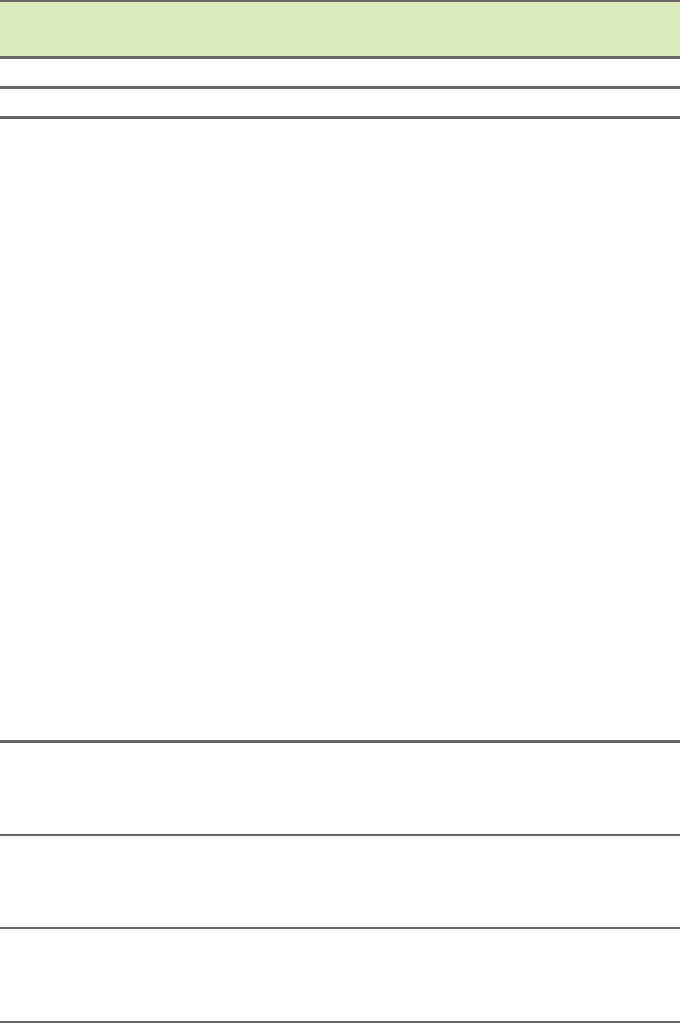
Specific absorption rate information
This device meets the EU requirements on the limitation of exposure
of the general public to electromagnetic fields by way of health
protection.
The limits are part of extensive recommendations for the protection of
the general public. These recommendations have been developed
and checked by independent scientific organizations through regular
and thorough evaluations of scientific studies. The unit of
measurement for the European Council's recommended limit for
mobile devices is the "Specific Absorption Rate" (SAR), and the SAR
limit is 2.0 W/kg averaged over 10 grams of body tissue. It meets the
requirements of the International Commission on Non-Ionizing
Radiation Protection (ICNIRP).
For body worn operation, this device has been tested and meets the
ICNIRP exposure guidelines and the European Standard, for use with
dedicated accessories. Use of other accessories which contain metals
may not ensure compliance with ICNIRP exposure guidelines.
The low band 5.15 to 5.35 GHz is for indoor use only.
This equipment complies with the essential requirements of the
European Union directive 1999/5/EC. See Statements of European
Union Compliance, and more details refer to the attached Declaration
of Conformity.
Lithuania LT Romania RO
Luxembourg LU Turkey TR
Country ISO 3166
2 letter code Country ISO 3166
2 letter code
English
Hereby, ACER INC., declares that this devise is in
compliance with the essential requirements and other
relevant provisionns of Directive 1999/5/EC.
Česky
[Czech]
ACER INC. tímto prohlašuje, že toto zařízení je ve
shodě se základními požadavky a dalšími příslušnými
ustanoveními směrnice 1999/5/ES.
Daansk
[Danish]
Undertegnede ACER INC. erklærer herved, at
følgende udstyr overholder de væsentlige krav og
øvrige relevante krav i direktiv 1999/5/EF.

24 - Warnings and regulatory information
Deutsch
[German]
Hiermit erklärt ACER INC., dass sich das Gerät
Radiolan in Übereinstimmung mit den grundlegenden
Anforderungen und den übrigen einschlägigen
Bestimmungen der Richtlinie 1999/5/EG befindet.
Eesti
[Estonian]
Käesolevaga kinnitab ACER INC. seadme vastavust
direktiivi 1999/5/EÜ põhinõuetele ja nimetatud
direktiivist tulenevatele teistele asjakohastele
sätetele.
Español
[Spanish]
Por medio de la presente ACER INC. declara que el
dispositivo cumple con los requisitos esenciales y
cualesquiera otras disposiciones aplicables o
exigibles de la Directiva 1999/5/CE.
Ελληνικά
[Greek]
∆ια του παρόντος η ACER INC. δηλώνει ότι η
παρούσα συσκευή συμμορφώνεται προς τις
ουσιώδεις απαιτήσεις και τις λοιπές διατάξεις της
Οδηγίας 1999/5/ ΕΚ.
Français
[French]
Par la présente ACER INC. déclare que cet appareil
est conforme aux exigences essentielles et aux
autres dispositions pertinentes de la directive 1999/5/
CE.
Íslenska
[Icelandic]
Hér með lýsir ACER INC. yfir því að er í samræmi við
grunnkröfur og aðrar kröfur, sem gerða r eru í tilskipun
1999/5/EC.
Italiano
[Italian]
Con la presente ACER INC. dichiara che questo
dispositivo è conforme ai requisiti essenziali ed alle
altre disposizioni pertinenti stabilite dalla direttiva
1999/5/CE.
Latviski
[Latvian]
Ar šo ACER INC. deklarē, ka šī ierīce atbilst
Direktīvas 1999/5/EK būtiskajām prasībām un citiem
ar to saistītajiem noteikumiem.
Lietuvių
[Lithuanian]
Šiuo ACER INC. deklaruoja, kad šis įrenginys atitinka
esminius reikalavimus ir kitas 1999/5/EB Direktyvos
nuostatas.
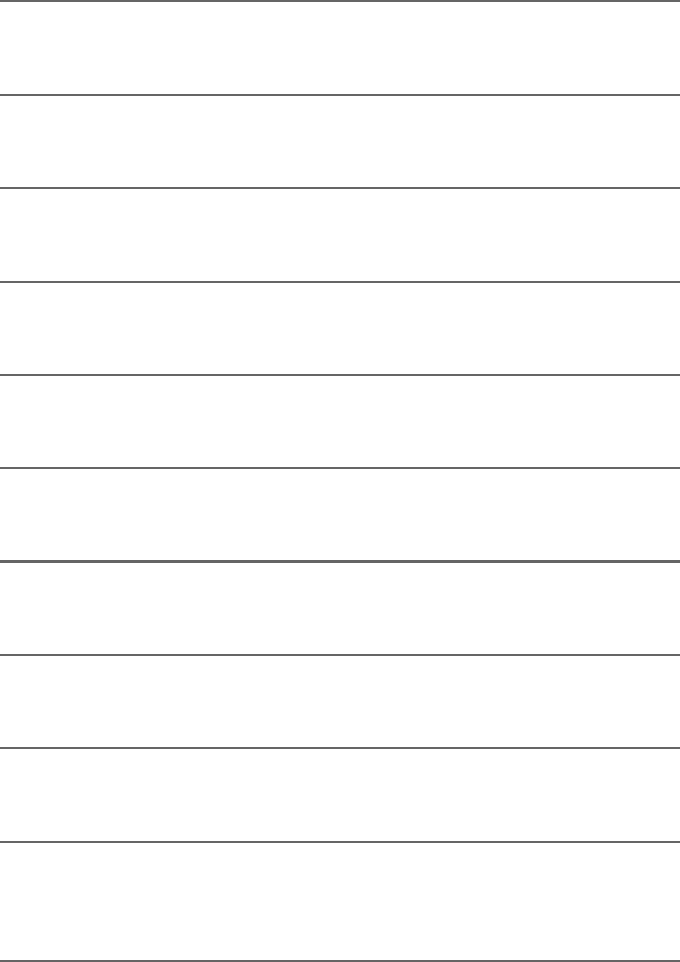
Warnings and regulatory information - 25
Malti
[Maltese]
Hawnhekk, ACER INC., jiddikjara li dan jikkonforma
mal- ti ijiet essenzjali u ma provvedimenti o rajn
relevanti li he mm fid-Dirrettiva 1999/5/EC.
Magyar
[Hungarian]
Alulírott, ACER INC. nyilatkozom, hogy a készülék
megfelel a vonatkozó alapveto követelményeknek és
az 1999/5/EC irányelv egyéb eloírásainak.
Nederlands
[Dutch]
Hierbij verklaart ACER INC. dat het toestel voldoet
aan de essentiële eisen en de andere relevante
bepalingen van richtlijn 1999/5/EG.
Norsk
[Norwegiann]
ACER INC. erklærer herved at utstyret er i samsvar
med de grunnleggende krav og øvrige relevante krav
i direktiv 1999/5/EF.
Polski
[Polish]
Niniejszym ACER INC. oświadcza, że urządzenie jest
zgodne z zasadniczymi wymogami oraz pozostałymi
stosownymi postanowieniami Dyrektywy 1999/5/EC.
Português
[Portuguese]
ACER INC. declara que este dispostivo está
conforme com os requisitos essenciais e outras
disposições da Directiva 1999/5/CE.
Slovensko
[Slovenian]
ACER INC. izjavlja, da je ta naprava skladna z
bistvenimi zahtevami in ostalimi relevantnimi določili
Direktive 1999/5/ES.
Slovensky
[Slovak]
ACER INC. týmto vyhlasuje, že zariadenie spĺňa
základné požiadavky a všetky príslušné ustanovenia
Smernice 1999/5/ES.
Suomi
[Finnish]
ACER INC. vakuuttaa täten että tämä laite on
direktiivin 1999/5/EY oleellisten vaatimusten ja sitä
koskevienn direktiivin muiden ehtojen mukainen.
Svenska
[Swedish]
Härmed intygar ACER INC. att denna enhet står i
överensstämmelse med väsentliga egenskapskrav
och övriga relevanta bestämmelser som framgår av
direktiv 1999/5/EG.

26 - Warnings and regulatory information
France
Pour la France métropolitaine :
2,400 - 2,4835 GHz (Canaux 1à 13) autorisé en usage intérieur
2,400 - 2,454 GHz (canaux 1 à 7) autorisé en usage extérieur
Pour la Guyane et la Réunion :
2,400 - 2,4835 GHz (Canaux 1à 13) autorisé en usage intérieur
2,420 - 2,4835 GHz (canaux 5 à 13) autorisé en usage extérieur
Pour tout le territoire Français :
Seulement 5,15 -5,35 GHz autorisé pour le 802.11a
L'utilisation de cet equipement (2,4 GHz WLAN) est soumise à
certaines restrictions :
• La puissance maximale autorisée en intérieur est de 100 mW pour
2400 - 2483,5 MHz.
• La puissance maximale autorisée est de 100 mW en extérieur pour
2400 - 2454 MHz.
• La puissance maximale autorisée est de 10 mW en extérieur, 2454 -
2483,5 MHz.
Pour les dernières restrictions, voir www.art-telecom.fr.
Italy
The use of this equipment is regulated by:
1.D.L.gs 1.8.2003, n. 259, article 104 (activity subject to general
authorization) for outdoor use and article 105 (free use) for indoor
use, in both cases for private use.
2.D.M. 28.5.03, for supply to public of RLAN access to networks and
telecom services.
L’uso degli apparati è regolamentato da:
1.D.L.gs 1.8.2003, n. 259, articoli 104 (attività soggette ad
autorizzazione generale) se utilizzati al di fuori del proprio fondo e
105 (libero uso) se utilizzati entro il proprio fondo, in entrambi i casi
per uso private.
2.D.M. 28.5.03, per la fornitura al pubblico dell’accesso R-LAN alle
reti e ai servizi di telecomunicazioni.

Warnings and regulatory information - 27
Belgium
Dans le cas d'une utilisation privée, à l'extérieur d'un bâtiment, au-
dessus d'un espace public, aucun enregistrement n'est nécessaire
pour une distance de moins de 300 m. Pour une distance supérieure
à 300 m un enregistrement auprès de l'IBPT est requise. Pour les
enregistrements et licences, veuillez contacter l'IBPT.
In geval van privé-gebruik, buiten een gebouw, op een openbare
plaats, is geen registratie nodig, wanneer de afstand minder dan
300 m is. Voor een afstand groter dan 300 m is een registratie bij
BIPT vereist. Voor registraties en licenties, gelieve BIPT te
contacteren.
Brazil
Este equipamento opera em caráter secundário, isto é, não tem
direito a proteção contra interferência prejudicial, mesmo de estações
do mesmo tipo, e não pode causar interferência a sistemas operando
em caráter primário.
Pakistan
Pakistan Telecommunication Authority (PTA) Approved.
Morocco
The operation of this product in the radio channel 2 (2417 MHz) is not
authorized in the following cities: Agadir, Assa-Zag, Cabo Negro,
Chaouen, Goulmima, Oujda, Tan Tan, Taourirt, Taroudant and Taza.
The operation of this product in the radio channels 4, 5, 6 and 7 (2425
- 2442 MHz) is not authorized in the following cities: Aéroport
Mohamed V, Agadir, Aguelmous, Anza, Benslimane, Béni Hafida,
Cabo Negro, Casablanca, Fès, Lakbab, Marrakech, Merchich,
Mohammédia, Rabat, Salé, Tanger, Tan Tan, Taounate, Tit Mellil,
Zag.
Japan
5 GHz 帯は室内でのみ使用のこと
Korea
당해 무선설비는 운용 중 전파혼신 가능성이 있음

28 - Warnings and regulatory information
Taiwan
第十二條
經型式認證合格之低功率射頻電機,非經許可,公司、商號或使用者均
不得擅自變更頻率、加大功率或變更原設計之特性及功能。
第十四條
低功率射頻電機之使用不得影響飛航安全及干擾合法通信 ; 經發現有干
擾現象時,應立即停用,並改善至無干擾時方得繼續使用。
前項合法通信,指依電信法規定作業之無線通信。
低功率射頻電機須忍受合法通信或工業、科學及醫療用電波輻射性電機
設備之干擾。
Modifications to the product
Acer cannot be held responsible for unauthorized modifications made
by the user and the consequences thereof, which may alter the
conformity of the product.
Compliant with Russian regulatory certification
ⓜ㙼㓏⒦⃚䞱❐᧨␅㲨䯉巵崭♙㽷㎞ℚ檔⃚⏶⹈咖㡈㆞Ⱁₚ᧶
᧭ᇬ巵崭᧤㡋䞱❐㦻浣᧨崹㢝㦇♙⮥▔㲨䯉᧥᧶∎䞷拝ㄵ㋟⍆⹂尥┪ᇭ
᧮ᇬ㽷㎞ℚ檔᧤㡋䞱❐崹㢝㦇♙⮥▔孬㲨䯉᧥᧶
ᇫᇫ᧤᧭᧥∎䞷᧯᧬⒕暧嵚↠㋾᧭᧬⒕暧
ᇫᇫ᧤᧮᧥᧮㸁ⅴₚㄋ⏡ₜ䦚娱ヤ᧨᧮㸁ⅴₙ㹞⮸䦚娱ヤₜ尐怔拝᧭⺞㣑
Canada — Industry Canada (IC)
This device complies with RSS210 of Industry Canada. Cet appareil
se conforme à RSS210 de Canada d'Industrie.
This device complies with Industry Canada license-exempt RSS standard(s).
Operation is subject to the following two conditions: (1) this device may not cause
interference, and (2) this device must accept any interference, including interference that
may cause undesired operation of the device.
Ce dispositif est conforme a la norme CNR-210 d'Industrie Canada applicable aux
appareils radio exempts de licence. Son fonctionnement est sujet aux deux conditions
suivantes: (1) le dispositif ne doit pas produire de brouillage prejudiciable, et (2) ce
dispositif doit accepter tout brouillage recu, y compris un brouillage susceptible de
provoquer un fonctionnement indesirable.
(Notice for 5GHz)
Caution :
(i) the device for operation in the band 5150-5250 MHz is only for indoor use to reduce the
potential for harmful interference to co-channel mobile satellite systems;
(ii) the maximum antenna gain permitted for devices in the bands 5250-5350 MHz and
5470-5725 MHz shall comply with the e.i.r.p. limit; and
(iii) the maximum antenna gain permitted for devices in the band 5725-5825 MHz shall
comply with the e.i.r.p. limits specified for point-to-point and non point-to-point operation as
appropriate.
(iv) Users should also be advised that high-power radars are allocated as primary users
(i.e. priority users) of the bands 5250-5350 MHz and 5650-5850 MHz and that these
radars could cause interference and/or damage to LE-LAN devices.
Avertissement:
Le guide d’utilisation des dispositifs pour réseaux locaux doit inclure des instructions
précises sur les restrictions susmentionnées, notamment :
(i) les dispositifs fonctionnant dans la bande 5 150-5 250 MHz sont réservés uniquement
pour une utilisation à l’intérieur afin de réduire les risques de brouillage préjudiciable aux
systèmes de satellites mobiles utilisant les mêmes canaux;
(ii) le gain maximal d’antenne permis pour les dispositifs utilisant les bandes 5 250-5 350
MHz et 5 470-5 725 MHz doit se conformer à la limite de p.i.r.e.;
(iii) le gain maximal d’antenne permis (pour les dispositifs utilisant la bande 5 725-5 825
MHz) doit se conformer à la limite de p.i.r.e. spécifiée pour l’exploitation point à point et
non point à point, selon le cas.
(iv) De plus, les utilisateurs devraient aussi être avisés que les utilisateurs de radars de
haute puissance sont désignés utilisateurs principaux (c.-à-d., qu’ils ont la priorité) pour
les bandes 5 250-5 350 MHz et 5 650-5 850 MHz et que ces radars pourraient causer du
brouillage et/ou des dommages aux dispositifs LAN-EL.
Radiation Exposure Statement:
The product comply with the Canada portable RF exposure limit set forth for an
uncontrolled environment and are safe for intended operation as described in this manual.
The further RF exposure reduction can be achieved if the product can be kept as far as
possible from the user body or set the device to lower output power if such function is
available.
Warnings and regulatory information --29
This Class B digital apparatus complies with Canadian ICES-003.
Cet appareil numérique de la classe B est conforme a la norme NMB-003 du Canada.
"To prevent radio interference to the licensed service, this device is intended to be
operated indoors and away from windows to provide maximum shielding. Equipment (or
its transmit antenna) that is installed outdoors is subject to licensing."
« Pour empêcher que cet appareil cause du brouillage au service faisant l'objet d'une
licence, il doit être utilisé a l'intérieur et devrait être placé loin des fenêtres afin de fournir
un écran de blindage maximal. Si le matériel (ou son antenne d'émission) est installé à
l'extérieur, il doit faire l'objet d'une licence. »
30 - Warnings and regulatory information
Exposure of humans to RF fields (RSS-102):
The computers employ low gain integral antennas that do not emit RF field in excess of
Health Canada limits for the general population; consult Safety Code 6, obtainable from
Health Canada's Web site at http://www.hc-sc.gc.ca/
The radiated energy from the antennas connected to the wireless adapters conforms to
the IC limit of the RF exposure requirement regarding IC RSS-102, Issue 4 clause 4.1.
SAR tests are conducted using recommended operating positions accepted by the
FCC/RSS with the device transmitting at its highest certified power level in all tested
frequency band without distance attaching away from the body.
Non-compliance with the above restrictions may result in violation of FCC RF exposure
guidelines.
Conformité des appareils de radiocommunication aux limites
d'exposition humaine aux radiofréquences (CNR-102):
L'ordinateur utilise des antennes intégrales à faible gain qui n'émettent pas un champ
électromagnétique supérieur aux normes imposées par Santé Canada pour la
population. Consultez le Code de sécurité 6 sur le site Internet de Santé Canada à
l'adresse suivante : http://www.hc-sc.gc.ca/
L'énergie émise par les antennes reliées aux cartes sans fil respecte la limite
d'exposition aux radiofréquences telle que définie par Industrie Canada dans la
clause 4.1 du document CNR-102, version 4.
Tests DAS sont effectués en utilisant les positions recommandées par la FCC/CNR
avec le téléphone émet à la puissance certifiée maximale dans toutes les bandes de
fréquences testées sans distance attacher loin du corps.
Non-respect des restrictions ci-dessus peut entraîner une violation des directives de la
FCC/CNR.